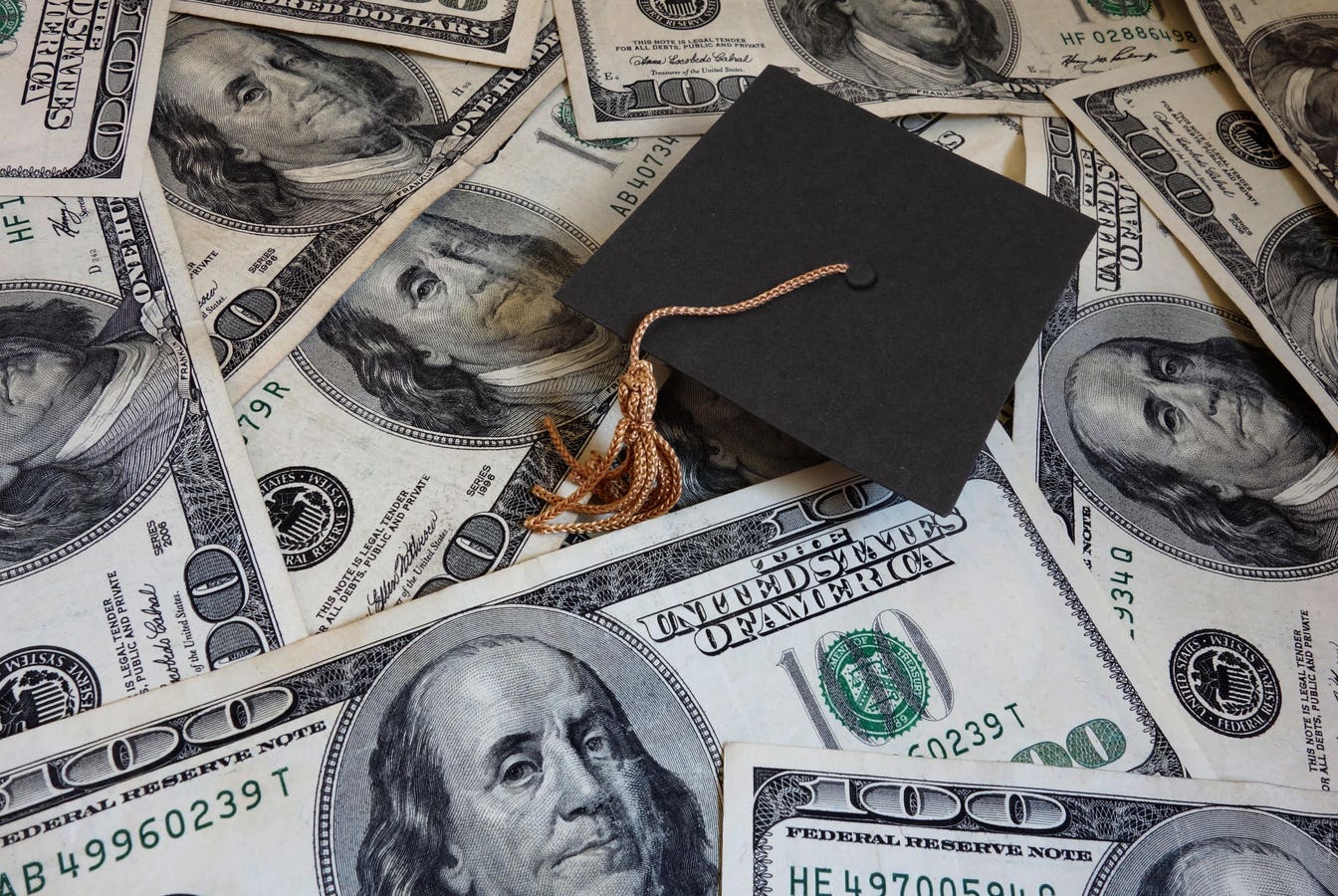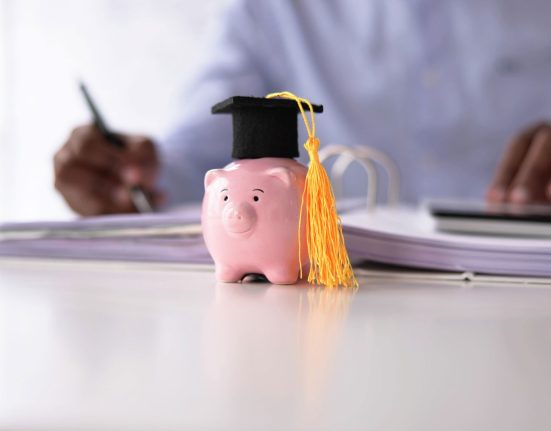New grads face rising student loan debt. Experts share tips on repayment, forgiveness plans and … More
Just graduated and wondering if you should throw your whole paycheck at student loans? You’re not alone.
“I used to think being debt-free was the only goal,” says Laurel Taylor, founder of the student loan debt platform Candidly. “But peace of mind? That comes from balance.”
That balance starts with your first financial move: smart saving. Because even in a high-rate world, putting yourself first—yes, even before student loan debt—can be a strategic flex.
Here’s the good news: Most federal student loans come with fixed interest rates (6.53% for undergrads, 8.08% for grad and professional students at the time of publication), way lower than the 21% interest you’d rack up on a credit card if your car breaks down or your job search stalls and you start charging daily expenses to get by. That’s where your emergency fund comes in.
We reviewed hundreds of high-yield savings accounts (HYSAs) and certificates of deposit (CDs) to find options for recent grads who want to stay stable, stack interest and still chip away at debt.
In this story, you’ll learn the smartest places to grow your savings, plus expert-backed strategies to balance student loan debt, avoid burnout and start building real financial momentum.
Related: Looking for the perfect banking solution? Compare products from multiple banks with Forbes Advisor.
Which Comes First: Student Loan Debt or Savings?
Before you throw your entire paycheck at your loans, take a breath. Slamming all your cash into debt might feel responsible, but it can backfire fast.
“If I could go back and give my younger self advice, it would be to take a balanced approach,”
Taylor says. That means covering your minimum payments while leaving room to invest in your future self.
If you don’t have savings or a safety net, a surprise like car trouble, a medical expense or job loss could send you into a financial crisis. Step back and assess your income, expenses and interest rates to build a plan that lets you chip away at debt while also protecting your savings account.
“Always have an emergency fund,” says Arizona State Treasurer Kimberly Yee. “In the short term, definitely pay down debt to avoid accruing interest. But new graduates can build their future with a long-term savings plan and maximize the power of compound interest.”
If you have private loans with high interest rates, you should prioritize those first.
Jenny Twomey of Earnest, a student loan refinance and lending company, recommends starting by focusing any extra payments on loans with higher interest rates (for example, anything above 8%). If your loans have manageable terms, though, she agrees with the other experts—start saving while chipping away at debt.
How Income and Loan Type Should Shape Your Repayment Plan
Not every graduate steps into a high-paying job or a stable career path. Your loan strategy should reflect your financial reality, not someone else’s.
“Never spend more than you make,” Yee says. “Use the 50/30/20 rule [for your spending]: 50% needs, 30% wants, 20% savings.”
Income-driven repayment plans on federal student loans adjust based on your earnings. That’s why Brian Safdari, CEO of College Planning Experts, advises recent grads with modest incomes to start with lower monthly payments and focus on building their cash reserves. As your income grows, increase your student loan payments to reduce principal and save on interest.
Private student loans typically come with fewer options and higher interest rates. Taylor recommends prioritizing these over federal loans when deciding which debt to pay down first. Federal loans often allow more flexibility, including deferment, forbearance and access to forgiveness programs.
Once your repayment plan is in place, the next step is growing your savings strategically. High-yield savings accounts and CDs are two of the safest, most reliable tools to build your financial cushion. No market risk required.
We’ve analyzed hundreds of options to bring you products worth considering based on yield, flexibility and fees. Just remember: your financial goals and timeline should shape your decision, so shop around and make sure these accounts work for you.
Best High-Yield Savings Accounts for New Grads Building a Safety Net
A HYSA is one of the easiest and safest ways to grow your money, without taking on risk. For new grads balancing student loan payments with big life transitions (hello, first apartment, first job, first “surprise” expense), a HYSA gives your savings a chance to earn while staying liquid and accessible.
Unlike traditional savings accounts that offer minimal returns, these accounts earn significantly higher interest, often 10 times more, without tying up your cash. Whether you’re building an emergency fund or stashing cash for short-term goals, these options offer strong APYs, no monthly fees and peace of mind. Every account listed is federally insured up to $250,000.
Here are some of the best high-yield savings accounts worth considering:
1. Synchrony High-Yield Savings Account – Rates and details as of 6/9/25
- APY: Great.
- Why we like it: A strong yield, access to ATMs and few fees.
- Best for: A stand-alone emergency fund that grows while you focus on loan payments.
- Keep in mind: Synchrony is online-only, with no checking option.
2. Capital One 360 Performance Savings – Rates and details as of 6/9/25.
- APY: Good.
- Why we like it: Offers both online convenience and in-person support through Capital One branches and cafés.
- Best for: Grads who want flexibility and access to a physical bank.
- Keep in mind: Interest compounds monthly rather than daily.
3. Barclays Online Savings – Rates and details as of 6/9/25.
- APY: Excellent.
- Why we like it: Charges few, if any, fees with no minimum deposit requirement.
- Best for: Savers looking for a no-cost account that earns a solid APY on all balances.
- Keep in mind: No ATM or check access.
Read more: Our picks of the best high-yield savings accounts
Best CDs for New Grads Ready to Lock In a High Yield
If you’ve got some extra savings you won’t need for a while, certificates of deposit can offer even higher interest rates than most savings accounts, without any market risk. CDs reward patience: the longer you commit to keeping your money in the account, the more you can earn.
For new grads, short- to mid-term CDs can be a strategic move, especially for money you’re not planning to spend soon (like savings for grad school or a future move). Just be sure you won’t need to dip into these funds early, since early withdrawal penalties can cancel out your earnings.
Here are three CD products worth considering:
1. Service Credit Union 6-Month Share Certificate – Details as of 6/2/25.
- APY: Good.
- Why we like it: Strong yield, low $500 minimum deposit and ideal for short-term savers.
- Best for: New grads or military families looking for risk-free, short-term growth.
- Keep in mind: You must qualify for membership, open a Primary Savings account and deposit $5 before opening a CD. Dividends are compounded monthly, not daily.
2. Capital One 12-Month CD – Rates and details as of 6/9/25.
- APY: Excellent.
- Why we like it: Highly competitive yield and no minimum deposit.
- Best for: First-time CD savers ready to grow funds for a year.
- Keep in mind: Early withdrawal penalties apply.
3. Synchrony 3- and 5-Year CDs – Rates and details as of 6/3/25.
- APY: Good.
- Why we like it: Competitive APYs, no minimum balance and daily compounding interest.
- Best for: Savers who won’t need access to funds for several years.
- Keep in mind: Long-term CDs come with steep early withdrawal penalties.
Read more: Our picks of the best CD rates
More Forgiveness Programs Exist Than You Think
And while locking in savings is smart, don’t overlook how loan forgiveness programs could boost your long-term finances, especially if you’re in a qualifying career path or repayment plan.
Safdari warns that many grads rush to pay off loans without considering potential forgiveness programs, often missing out on long-term savings.
But rules around forgiveness aren’t as clear as they used to be. Recent court rulings have paused forgiveness under some income-driven repayment plans, such as SAVE. That’s because SAVE, like several other repayment options, was created by the Department of Education, not directly by Congress, and doesn’t require a vote to be changed.
But that doesn’t mean forgiveness is gone entirely.
Forgiveness under the Income-Based Repayment (IBR) Plan is still allowed. If you switch to IBR, any payments you’ve made under paused plans like SAVE may still count toward the forgiveness timeline under IBR.
Other forgiveness paths remain available as well. For example, under the Teacher Loan Forgiveness Program, qualifying teachers can receive up to $17,500 in federal student loan forgiveness if they work five consecutive years in a low-income school or agency. Additional eligibility criteria, like qualifications and loan type, apply.
“The biggest mistake is not having a plan,” Safdari says. “Hire a financial coach or advisor. Don’t try to pay too fast if forgiveness applies to your career.”
Taylor also encourages new grads to explore additional state-based programs for professions such as education, healthcare, social work and veterinary work.
Twomey notes that many federal borrowers are defaulted into the standard 10-year repayment plan, even when income-driven options would be a better fit.
“There are multiple repayment plans, and understanding each is key to choosing the right one,” she says.
Graduating with student debt is a heavy lift, but it doesn’t have to hold you back. Build a strategy that fits your life, make use of the tools and programs available to you and don’t be afraid to ask questions. As Yee puts it, “Achieving financial freedom is a gift worth working toward.”
Related: Looking for the perfect banking solution? Compare products from multiple banks with Forbes Advisor.







